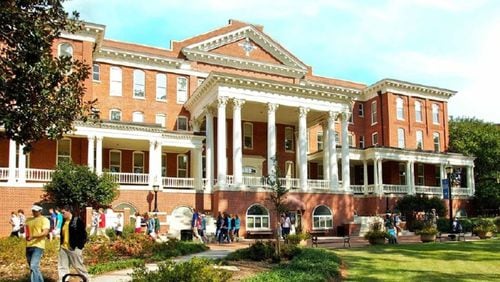Over the holidays, I talked to several parents of high school seniors trying to decide on colleges. A common concern: Should they push their children to Georgia's top public campuses, many of which are large, or suggest smaller schools where students are less likely to get lost?
My older kids attended a mix of big (University of Georgia), medium (Emory) and small (Oberlin.) And my youngest – my twins – are now at UGA and Georgia Tech. Where kids will flourish may depend on what I call the cheeseburger test. If your children order a burger with cheese at a busy lunch spot and it arrives naked, will they flag down the server and request a new sandwich? Or, will they hiss to you that it’s fine and stop making a fuss?
The teen who does not want to impose on anyone or make a fuss may face challenges at a big school where students have to sometimes take off their shoe and pound on the table to be noticed. This is often hard for first-generation college students who won praise in K-12 schools for not bothering the adults in the building. But keeping your head down in college can lead to being overlooked and running into walls, especially on a big campus where opportunities abound but are not delivered to your door.
For example, registering for classes at most large campuses resembles navigating I-285 at rush hour. Timing is key, and you have to seize an opening. It’s a daunting enough gauntlet that students complain to me that the inability to take the courses they need threatens their on-time graduation. (I have to note that 20 years ago I heard this a lot from Georgia State University students. I don’t anymore, which may owe to its celebrated student tracking system.)
When I went to the mass orientation at UGA this summer with my daughter, she ended up with the last slot of the day to meet with an adviser in her major to select classes. It was way across campus so we drove, and I waited in the hallway since we had to dash back to a building on main campus to register. Since my daughter was the final advisee, the advisor walked out with her and chatted for a moment. I asked whether, at this late hour, my daughter would be able to get into all the classes the two of them had chosen or whether she needed a Plan B. She could get into the classes, I was assured.
It turned out my daughter needed a Plan B and C – some of her second and third choices were filled.
When this happened to her again this semester, I asked a UGA administrator why it was so hard to get courses. Her response: “This year has been particularly harder because the incoming class was much larger than expected. The university typically aims for about 5000 first year students to begin each fall. This year, a record number actually showed for orientation and attendance. I think I heard around 5800.”
One smart mom – a UGA grad herself with a grip on what courses students need for what major -- shared her son’s orientation/registration saga. Her son was a transferee to UGA’s business school and left his 20-minute advisement session with a collection of classes that his mother felt didn’t make sense. Earlier that day at orientation, they’d heard a dean in the business school speak so she told her son they were going to track down the woman and seek her advice. The dean was in her office and sat down with the young man and reviewed his schedule. She agreed the classes were wrong for him given his strong grades and enrolled him in an entirely different set. (She could override classes marked full.)
The mom told me her son learned an important lesson: You have to be willing to reach out to make things happen and go higher, if necessary. Students at large schools can't expect resolution to problems with a single email.
Of course, there are great advantages to big schools, especially for high-energy teens who need an ever-changing array of options. If you child wants to be in a mosh pit one night and an orchestra pit the next, a small school might not work. I talked to a student at Georgia College & State University in Milledgeville who is considering switching to Georgia State. She likes the 24/7 energy of a city campus and wants hot and cold running poetry slams, karaoke and German film festivals.
Kids who thrive at smaller schools are often more focused on relationships than experiences; they want to run into their professors on the quad or the campus coffee shop. They like seeing the same classmates; they find familiar faces reassuring. They don’t want to arm wrestle to get classes or plum internships.
I attended large schools for both undergrad and graduate school, but was probably a better match for smaller campuses. (I would have loved a Georgia College.) I think the mismatch was why I rushed through undergrad, finishing a year early.
How common are mismatches? The National Student Clearinghouse Research Center found 37.2 percent of college students changed schools at least once within six years. The center looked at the cohort of U.S. students who began college in 2008 and graduated by 2014. That included 79,422 Georgians, 30,000 of whom transferred at least once, giving the state a transfer rate slightly higher, at 37.85 percent, than the national average. The center did not discern why students transferred; certainly, finances played a role. But I suspect some students simply didn't feel comfortable at their schools.
My oldest daughter has a master's in public policy from Georgetown and ran a dual enrollment program at a New York college. In talking with me about this, she made an interesting point. "You have to wonder if the difficulty in the advising and registration process affects retention. These are students who are not securely into their majors and may feel adrift after the structure and support present in many high schools," she said. "Many freshman would benefit immensely from a significant increase in the time and attention spent on early advising. With dual enrollment we seek to improve the transition between high school and college. The more core classes a student has completed, the more quickly they can jump to major specific courses where they will see the same faces and professors, regardless of campus size.”
With effort, students can create a fulfilling life at any college, but it takes a year in my view to figure out how. Several friends have lamented their college freshman is not excited about returning to campus, especially those with roommate woes. (That is a column for another day.) Most of them will discover, probably sometime in April when the campus is abloom and everything seems possible, that they can make this work.







